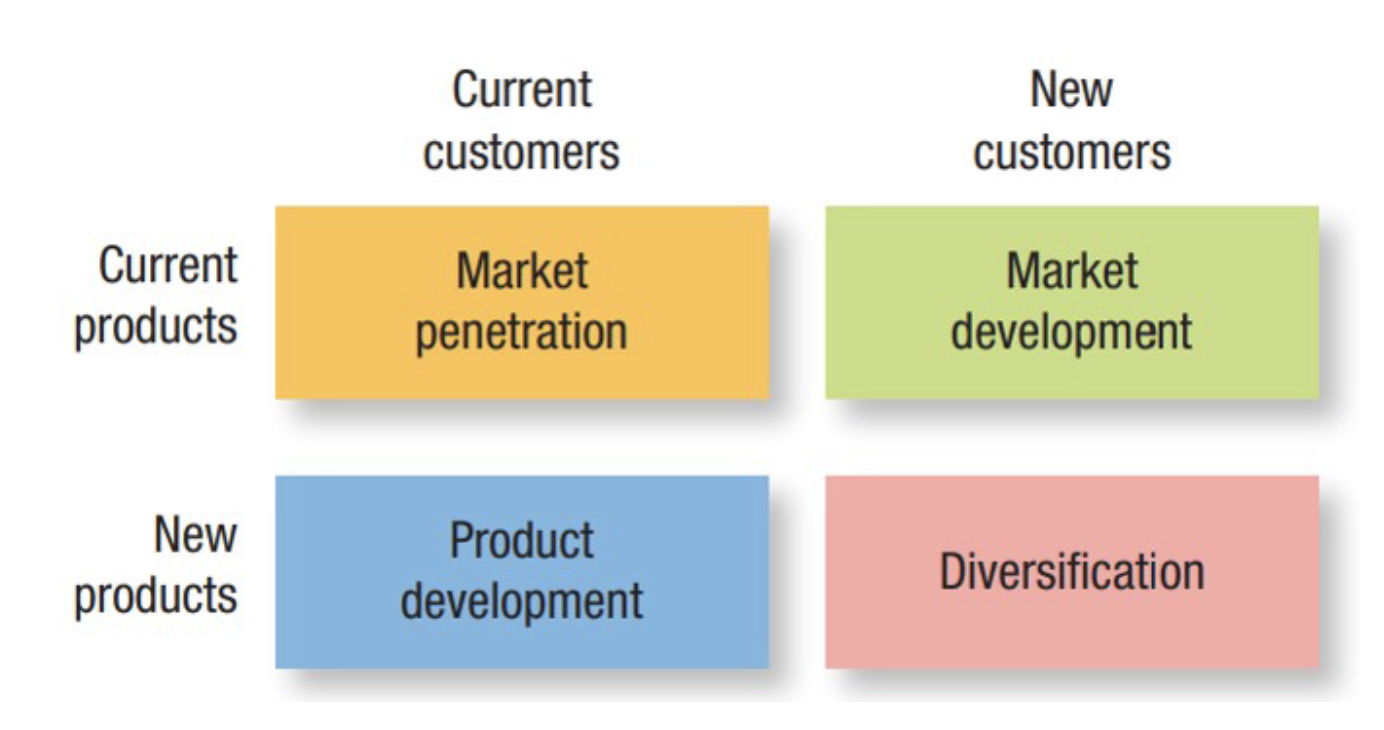ADM 2315 - CHAP 17
1/6
There's no tags or description
Looks like no tags are added yet.
Name | Mastery | Learn | Test | Matching | Spaced |
|---|
No study sessions yet.
7 Terms
ASSESSING GROWTH OPPORTUNITIES
• Consider:
– The types of products and markets a company should
focus on
– The ways in which a company can manage its
product–market growth strategy over time
– Assessing growth opportunities includes planning new businesses, downsizing, and terminating older businesses. If there is a gap between future desired sales and projected sales, corporate management will need to develop or acquire new businesses to fill it
PRODUCT-MARKET GROWTH FRAMEWORK - ANSOFF MATRIX
– Market penetration strategy-easiest to implement. Encourage
customers to buy more by showcasing benefits or find new uses for existing products
– Market development strategy-try to identify users in current
sales areas, choose another market to target, expand distribution channels, sell in new locations etc.
– Product development strategy-develop new product features,
replce product with newer model
– Diversification strategy
1)concentric strategy- seek new products that have technological or marketing synergies with existing product lines, even though they appeal to a different group of customers.
2) horizontal strategy- produce complementary products, even though they
might require a different manufacturing process.
3) conglomerate strategy - the company might seek new businesses with
no relationship to its current technology, products, or markets

DIVERSIFICATION STRATEGIES
1) concentric strategy- seek new products that have technological or marketing synergies with existing product lines, even though they appeal to a different group of customers.
2) horizontal strategy- produce complementary products, even though they might require a different manufacturing process.
3) conglomerate strategy - the company might seek new businesses with no relationship to its current technology, products, or markets
GAINING MARKET POSITION
– Share of market-sales revenue, units sold
– Share of mind-%age of customers that bring to mind
specific company in industry
– Share of heart- % age customers that name a
company as the preferred place to purchase
– Companies that make steady gains in mind share and heart share will inevitably make gains in market share and
profitability.
– A market leader has the largest market share and usually leads in price changes, new-product introductions, distribution coverage, and promotional intensity.
DEFENDING MARKET POSITION
While trying to expand total market size, the dominant firm must actively defend its current business
How can the leader achieve this? The most constructive response is continuous innovation. The front-runner should lead the industry in developing new products and customer services, distribution effectiveness, and cost cutting.
• Responsive marketing
– Find a stated need and fill it
• Anticipative marketing
– Look ahead to new needs
• Creative marketing
– Find solutions to needs
consumers didn’t ask for but
like getting
• Defense strategies
1. Position defense: Nike's "Just Do It" campaign positioned the brand as the top choice for athletic apparel and footwear, making it hard for competitors to challenge its dominance.
2. Flank defense: Coca-Cola's introduction of Coke Zero targeted the market segment looking for a zero-calorie option, protecting its main brand from competitors in the diet soda category.
3. Preemptive defense: Amazon's expansion into same-day delivery and grocery services preemptively countered potential moves by competitors, keeping them from gaining a foothold in these areas.
4. Counteroffensive defense: When Pepsi launched the "Pepsi Challenge" to directly challenge Coca-Cola's taste superiority claims, it met the competitor frontally and hit its flank by highlighting a perceived weakness.
5. Repositioning defense: Old Spice's "The Man Your Man Could Smell Like" campaign repositioned the brand from a traditional, older audience to a younger, more dynamic one, expanding its market reach.
6. Contraction defense: Yahoo's decision to divest from its search and advertising businesses and focus on its core media and news offerings was a strategic contraction to strengthen its position in those areas.
PRODUCT LIFE CYCLE MARKETING STRATEGIES
• Product life cycle
– Introduction
• Sales growth is low
• Profits are negative or low
• Promotional expenditures are high
• Prices are higher
• Focus is on buyers who are the most ready to buy
– Growth
• Improve product quality and add new features
• Add new models and flanker products
• Enter new market segments
• Increase distribution coverage and enter new distribution channels
• Shift from awareness and trial communications to preference and loyalty communications
• Lower prices to attract the next layer of price-sensitive buyers
– Maturity
• Growth-sales start to slow
• Stability-sales flatten, saturation
reached
• Decaying maturity-sales slow,
consumer try substitutes, most
challenging stage, weaker
competition withdraws as competition
is intensified
• Strategies:
– Market growth
▪ Convert nonusers
▪ Attract competitors’ customers
▪ Increase usage among current users
– Increase the number of usage occasions
– Increase consumption with each occasion
– Create new usage occasions
– Product modification
▪Quality improvement
▪Feature improvement
▪Style improvement
– Decline
• Harvesting and Divesting
– Harvesting
– Divesting
• Eliminating Weak Products
FADS & TRENDS
Fads
“unpredictable, short-lived, and without social, economic, and political significance.”
Fads come quickly into public view, are adopted with great zeal, peak early, and decline very fast. Their acceptance cycle is short, and they tend to attract only a limited following searching for excitement or wanting to distinguish themselves from others.
Trends
“a direction or sequence of events with momentum and durability.”
Trends are more predictable and durable than fads; they reveal the shape of the future and can provide strategic direction.